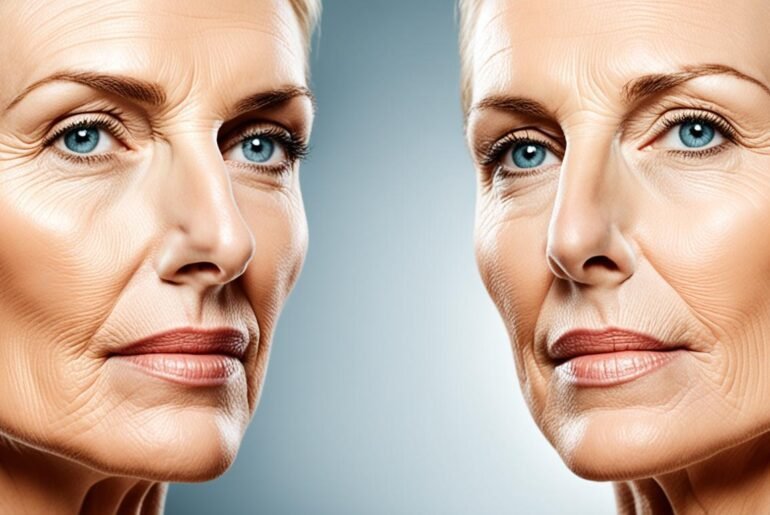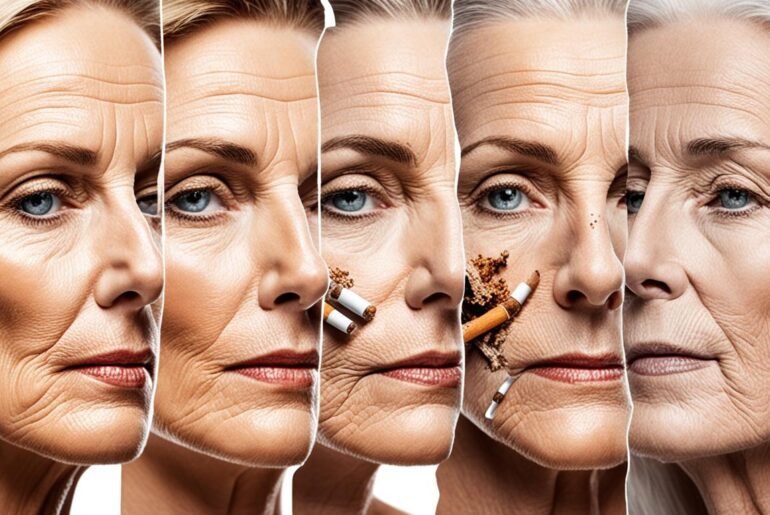Did you know that smoking can accelerate skin aging, making you look older than your actual age? It’s true! The effects of smoking on the skin are undeniable, leading to wrinkles, sagging skin, uneven skin tone, and an increased risk of skin cancer. If you’re a smoker, it’s important to understand the impact of smoking on your skin and take steps to mitigate the damage.
Smoking contributes to skin aging by causing collagen and elastin breakdown, reducing moisture in the skin, and narrowing blood vessels. This leads to wrinkles, sagging skin, and an uneven skin tone. Quitting smoking can help reverse some of the damage and improve skin health.
Key Takeaways:
- Smoking accelerates skin aging, leading to wrinkles, sagging skin, and uneven skin tone.
- Collagen and elastin breakdown, reduced skin moisture, and narrowed blood vessels are some of the ways smoking affects the skin.
- Quitting smoking can help reverse skin damage and improve overall skin health.
- Protecting your skin from smoking-induced aging requires a comprehensive approach that includes quitting smoking and practicing good skin care.
- There are resources available to help individuals quit smoking, such as nicotine replacement therapy, support groups, and mobile apps.
How Smoking Contributes to Wrinkles
Smoking is not only harmful to your overall health but also takes a toll on your skin, leading to the formation of wrinkles. The effects of smoking on the skin can be attributed to the breakdown of collagen and elastin fibers, two essential components responsible for maintaining skin elasticity and firmness.
Collagen breakdown: Smoking accelerates collagen breakdown, leading to sagging and wrinkling of the skin. Collagen provides structure and support to the skin, and when it breaks down, the skin loses its ability to bounce back, resulting in the formation of wrinkles.
Elastin degradation: Elastin is responsible for giving the skin its elasticity, allowing it to stretch and return to its original shape. Smoking impairs the production of elastin and promotes its breakdown, making the skin lose its natural resilience and contributing to the formation of wrinkles.
In addition to collagen and elastin breakdown, smoking also reduces moisture in the skin. The heat and chemicals in cigarette smoke deplete the skin’s natural hydration, making wrinkles more visible and exacerbating the signs of aging.
Furthermore, the act of smoking itself can contribute to the development of wrinkles, particularly around the lips. The repetitive motion of puckering the lips while smoking can lead to the formation of fine lines and wrinkles, commonly known as lip wrinkles.
The Impact of Smoking on Skin Tone and Pigmentation
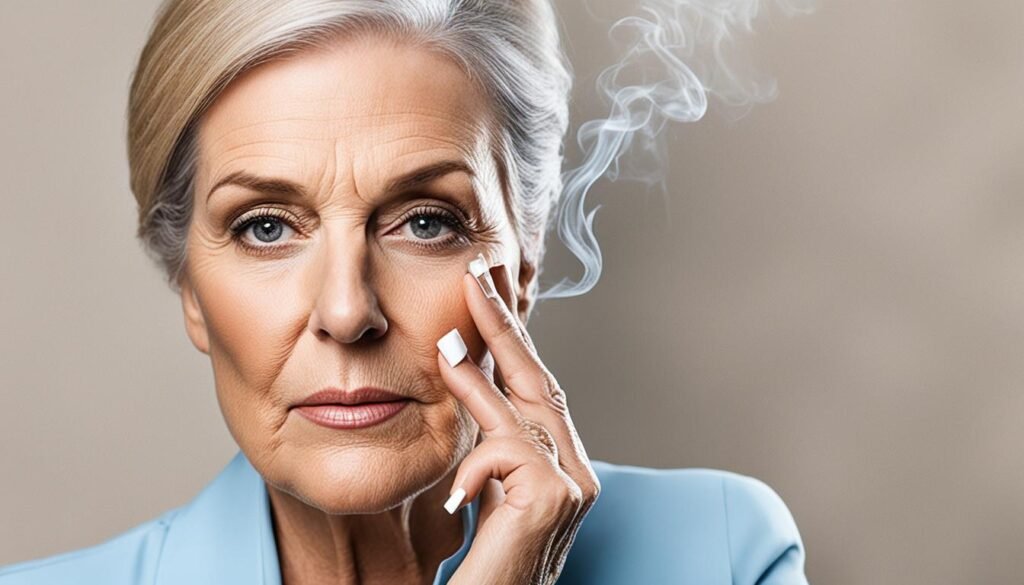
Smoking can have a significant impact on skin tone and pigmentation. One of the effects of smoking is the promotion of melanocyte formation, which can lead to the development of age spots and dark spots on the skin. These pigment-producing cells become more active under the influence of smoking, resulting in uneven skin tone and pigmentation.
Furthermore, individuals who smoke often experience dull and pale skin that may appear bluish or gray. This is primarily due to the restricted blood flow caused by smoking, which reduces the oxygen and nutrient supply to the skin. As a result, the complexion can appear lackluster and unhealthy.
To combat the negative effects of smoking on skin tone and pigmentation, quitting smoking is crucial. By quitting smoking, individuals can improve their skin tone and restore a healthier complexion. The cessation of smoking allows for better blood flow, increased oxygenation, and improved nutrient supply to the skin, resulting in a more even skin tone and improved pigmentation.
| Effects of Smoking on Skin Tone and Pigmentation | Benefits of Quitting Smoking |
|---|---|
| 1. Promotion of melanocyte formation | 1. Improved blood flow to the skin |
| 2. Development of age spots and dark spots | 2. Increased oxygenation of the skin |
| 3. Uneven skin tone and pigmentation | 3. Enhanced nutrient supply to the skin |
| 4. Dull and pale complexion | 4. Restoration of a healthier complexion |
Quitting smoking not only addresses the visible effects of smoking on the skin but also offers numerous other health benefits. It is a crucial step in improving overall well-being and promoting a more youthful appearance.
The Effects of Smoking on Sagging Skin
https://www.youtube.com/watch?v=c3DmVo3HO9I
Smoking has severe consequences for the firmness and elasticity of the skin, leading to sagging and loss of tone. The harmful chemicals present in tobacco smoke can damage the collagen and elastin fibers, which are crucial for maintaining skin strength and elasticity. Collagen degradation occurs, reducing the production of elastin, resulting in skin that is more prone to sagging.
The detrimental effects of smoking on collagen and elastin fibers lead to a loss of skin firmness and elasticity, making the skin appear loose and saggy. This can be particularly evident in areas such as the face, neck, and breasts. The impact of smoking on sagging skin is more pronounced with long-term smoking and heavy smoking habits.
Quitting smoking is a crucial step in slowing down the progression of sagging skin and promoting collagen and elastin production. When you stop smoking, the body can start to repair some of the damage caused by smoking. Collagen production can increase, improving the firmness and elasticity of the skin.
It’s important to note that quitting smoking alone may not completely reverse all the effects of smoking on sagging skin. However, it is a significant step towards improving skin health and preventing further damage. Combining smoking cessation with a comprehensive skincare routine and professional treatments can enhance the overall results.
By quitting smoking, individuals give their skin a chance to recover and regain some of its firmness and elasticity, leading to a more youthful and rejuvenated appearance.
| Effects of Smoking on Sagging Skin | Possible Solutions |
|---|---|
| Damage to collagen and elastin fibers | Quit smoking |
| Reduction in skin firmness and elasticity | Adopt a comprehensive skincare routine |
| Pronounced sagging in facial, neck, and breast areas | Consider professional treatments such as collagen-inducing therapies |
| Long-term and heavy smoking habits worsen sagging | Protect the skin from further damage by avoiding secondhand smoke and harmful environmental factors |
Although quitting smoking is the most effective way to minimize the effects of smoking on sagging skin, it’s essential to remember that skin health is a long-term commitment. Consistent care and protection are necessary to maintain and improve the firmness and elasticity of the skin. Consulting with a dermatologist or skincare professional can provide personalized guidance on the best approaches for your specific skin concerns.
Smoking and Delayed Wound Healing
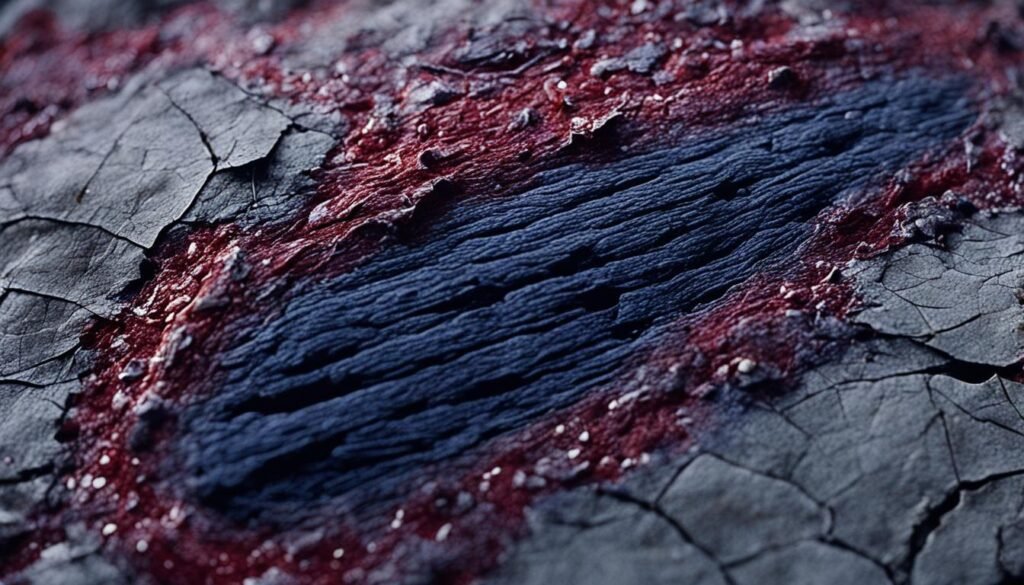
Smoking has detrimental effects on the body’s ability to heal wounds, leading to delayed wound healing, increased risk of infection, and higher rates of surgical complications. The negative impact of smoking on wound recovery is attributed to several factors, including inflammation, compromised immune response, and impaired blood flow.
Cigarette smoke contains harmful chemicals that can impede the body’s inflammatory response, which is crucial for initiating the healing process. Inflammation is a natural defense mechanism that helps remove debris, fight infection, and promote tissue repair. However, smoking reduces the body’s inflammatory response, resulting in delayed wound healing.
In addition to inflammation, smoking compromises the immune system, making individuals more susceptible to infections. The chemicals in tobacco smoke weaken the body’s ability to fight off bacteria and other pathogens, increasing the risk of infection at the site of the wound. This can lead to prolonged healing times and potential complications.
Furthermore, smoking diminishes blood flow to the wound site due to the constriction of blood vessels caused by the chemicals in cigarettes. Adequate blood flow is essential for delivering oxygen and nutrients to the healing tissues. Without sufficient blood supply, the wound healing process is hindered, resulting in slower healing and potential complications.
Quitting smoking is crucial for optimizing wound healing and reducing the associated risks. Studies have shown that quitting smoking at least four weeks before a surgical procedure can significantly improve wound healing outcomes and decrease the likelihood of complications.
Table: Effects of Smoking on Wound Healing
| Effects of Smoking | Consequences for Wound Healing |
|---|---|
| Decreased inflammatory response | Delayed wound healing |
| Compromised immune response | Increased risk of infection |
| Impaired blood flow | Higher rates of surgical complications |
Quitting smoking allows the body to recover from the harmful effects of smoking, improving the inflammatory response, boosting the immune system, and restoring proper blood flow to the wound site. This enhances the body’s natural healing mechanisms and reduces the risk of infection and surgical complications.
By prioritizing smoking cessation prior to any surgical procedure and adopting a smoke-free lifestyle, individuals can promote better wound healing, ensuring optimal recovery and minimizing potential complications.
The Link Between Smoking and Skin Cancer
Smoking has long been recognized as a significant risk factor for various types of cancer, including lung cancer. However, the harmful effects of smoking extend beyond the respiratory system. Research has shown a clear link between smoking and an increased risk of developing skin cancer, such as squamous cell carcinoma and melanoma.
Smokers face a higher risk of squamous cell carcinoma, a type of skin cancer that often arises from precancerous skin lesions called actinic keratoses. Studies have shown that smoking increases the number, size, and severity of these precancerous lesions, leading to a higher likelihood of their progression to squamous cell carcinoma. The chemicals present in tobacco smoke, including polycyclic aromatic hydrocarbons and nicotine, can directly damage DNA and disrupt the normal self-renewal process of skin cells, contributing to the development of cancer.
In addition to squamous cell carcinoma, smoking is also associated with an increased risk of melanoma, the most dangerous form of skin cancer. Melanoma occurs when melanocytes, the pigment-producing cells in the skin, become malignant. Smoking can affect the function of melanocytes and promote their abnormal growth, leading to the development of melanoma. Furthermore, smokers diagnosed with melanoma tend to have a lower survival rate compared to non-smokers, highlighting the detrimental effects of smoking on cancer prognosis.
Cigarette smoke contains a complex mixture of chemicals that can impair the immune system’s ability to recognize and eliminate cancer cells. Smoking-induced inflammation and oxidative stress can also suppress immune responses, facilitating the growth and spread of cancer cells. These factors, combined with the direct DNA damage caused by smoking, contribute to an increased risk of skin cancer among smokers.
To illustrate these findings, consider the following table that compares the risk of developing skin cancer between smokers and non-smokers:
| Risk of Squamous Cell Carcinoma | Risk of Melanoma | |
|---|---|---|
| Smokers | 1.5-2 times higher | 1.5 times higher |
| Non-smokers | Lower risk | Lower risk |
As shown in the table, smokers have a significantly higher risk of both squamous cell carcinoma and melanoma compared to non-smokers.
Fortunately, quitting smoking can reduce the risk of skin cancer. Research has shown that individuals who quit smoking experience a gradual decrease in their risk of developing skin cancer over time. The sooner someone quits smoking, the greater the potential benefits in terms of reducing their skin cancer risk.
Protecting Your Skin from Smoking-Related Skin Cancer
If you are a smoker, quitting smoking is the most effective way to reduce your risk of skin cancer. In addition to quitting, follow these tips to protect your skin:
- Practice sun protection by wearing sunscreen with a high SPF, seeking shade, and wearing protective clothing, including a wide-brimmed hat and sunglasses.
- Perform regular skin self-examinations to detect any changes in moles or the appearance of new spots. Consult a dermatologist if you notice any suspicious growths.
- Stay hydrated by drinking plenty of water and use moisturizers to keep your skin hydrated.
- Eat a balanced diet rich in antioxidants, vitamins, and minerals to support skin health.
- Avoid tanning beds and excessive exposure to ultraviolet (UV) radiation.
By quitting smoking and taking steps to protect your skin, you can reduce your risk of skin cancer and promote the health and vitality of your skin. It’s never too late to quit smoking and start prioritizing your skin’s well-being.
Smoking and Other Skin Conditions
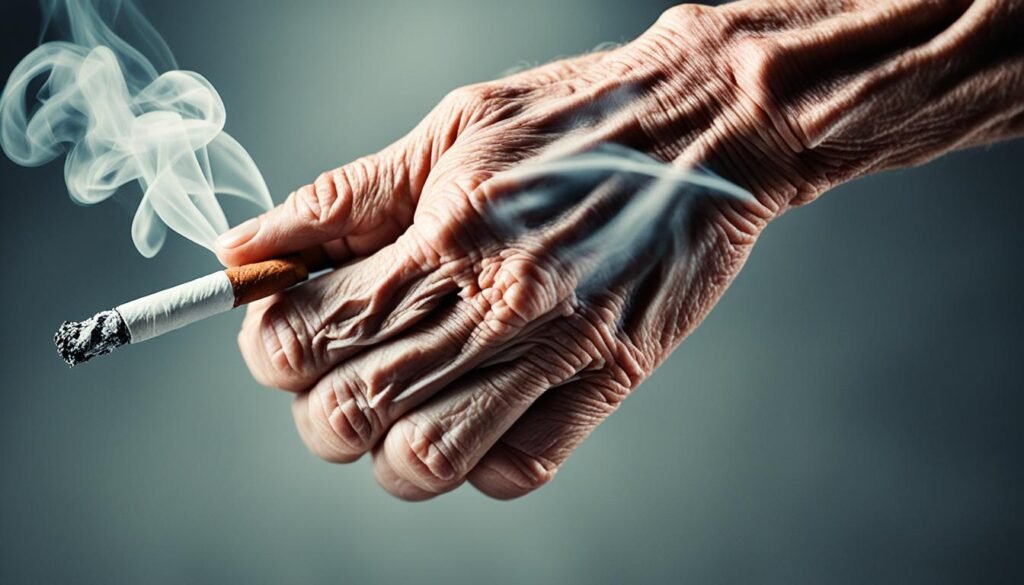
Smoking has been linked to various skin conditions, including psoriasis, eczema, acne, vasculitis, lupus, and alopecia. The chemicals in tobacco smoke can trigger inflammation and immune dysfunction, exacerbating these conditions. Quitting smoking can help improve the symptoms and severity of these skin conditions.
| Skin Condition | Link to Smoking |
|---|---|
| Psoriasis | Smoking can worsen the symptoms and increase the risk of developing psoriasis. |
| Eczema | Smoking can trigger flare-ups and make eczema symptoms more severe. |
| Acne | Smoking has been associated with an increased risk of developing acne. |
| Vasculitis | Smoking can contribute to the development and progression of vasculitis, an inflammation of the blood vessels that affects the skin. |
| Lupus | Smoking has been shown to worsen the symptoms of lupus, an autoimmune disease that can also affect the skin. |
| Alopecia | Smoking may be associated with hair loss, including a condition called alopecia areata. |
The Effects of Smoking on Skin Texture
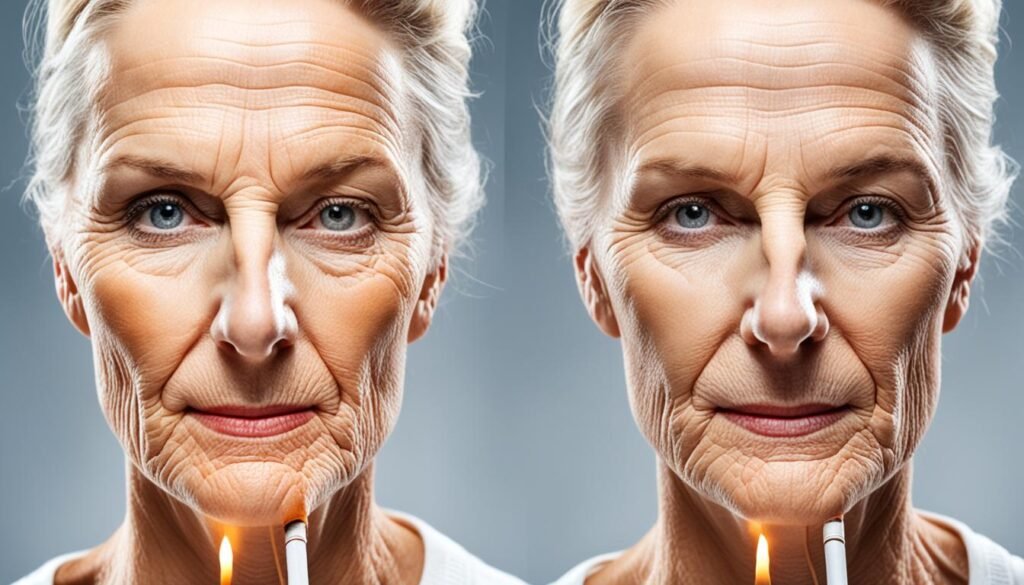
Smoking can have detrimental effects on the texture of the skin, resulting in a rough, dull, and uneven appearance. The chemicals present in tobacco smoke disrupt the skin’s natural barrier function, leading to various skin texture issues.
One of the skin conditions associated with smoking is polymorphic light eruption. This condition is characterized by the development of itchy, reddish rashes on the skin, especially when exposed to sunlight. Smoking can exacerbate the symptoms of polymorphic light eruption, further compromising the texture of the skin.
Another condition that can be worsened by smoking is palmoplantar pustulosis. This is a chronic skin condition that leads to the formation of deep, painful, pus-filled blisters on the palms of the hands and soles of the feet. Smoking can contribute to the severity of palmoplantar pustulosis and negatively affect the texture of the affected areas.
Smoking is also known to be associated with rosacea, a chronic inflammatory skin condition that primarily affects the face. Rosacea can cause redness, flushing, and the appearance of small, pus-filled bumps on the skin. Smoking can aggravate the symptoms of rosacea and contribute to the uneven texture of the affected facial skin.
By quitting smoking, individuals can improve the texture of their skin and reduce the risk of developing these conditions. Quitting smoking allows the skin to recover and regain its natural resilience and smoothness.
| Condition | Description |
|---|---|
| Polymorphic Light Eruption | Development of itchy, reddish rashes, especially upon sunlight exposure |
| Palmoplantar Pustulosis | Formation of deep, painful, pus-filled blisters on the palms and soles |
| Rosacea | Chronic inflammatory condition causing redness, flushing, and small bumps on the face |
Benefits of Quitting Smoking for Skin Health

Quitting smoking can have significant benefits for skin health. When you quit smoking, your skin can start to show improvements within a few weeks to months. Let’s explore the positive effects of quitting smoking on your skin:
Improved Collagen Production
Collagen is a protein that is essential for maintaining skin elasticity and firmness. Smoking can damage collagen fibers, leading to sagging skin. However, when you quit smoking, your body’s ability to produce collagen improves. This helps restore skin elasticity, making it appear healthier and more youthful.
Reduced Appearance of Wrinkles and Age Spots
Smoking contributes to the formation of wrinkles and age spots. The chemicals in tobacco smoke can accelerate skin aging, making these signs more prominent. Quitting smoking allows your skin to recover as it reduces the damage caused by smoking. Over time, you may notice a visible reduction in the appearance of wrinkles and age spots.
Promotion of Better Wound Healing
Smoking impairs the body’s ability to heal wounds, leading to delayed recovery and an increased risk of infection. Quitting smoking can help improve wound healing by restoring the natural healing processes of the body. This is particularly important if you are planning to undergo any surgical procedures.
Restoration of a Healthier Complexion
Smokers often have dull, uneven skin tone that may appear bluish or gray due to reduced blood flow and oxygen supply to the skin. By quitting smoking, you are allowing your skin to receive an improved flow of oxygen and nutrients. This can help restore a healthier complexion, giving your skin a vibrant and youthful look.
Reversal of Smoking-Related Skin Damage
Quitting smoking gives your skin a chance to heal and recover from the damage caused by tobacco smoke. The act of quitting reduces further exposure to harmful chemicals, allowing your skin to gradually reverse the effects of smoking. This can ultimately lead to improved skin health and a more youthful appearance.
If you’re considering quitting smoking, remember that the benefits extend beyond just improving your skin health. It also has numerous positive effects on your overall well-being. Take the first step towards healthier skin and a healthier you by quitting smoking today.
Skin Care Tips to Reverse the Effects of Smoking

In addition to quitting smoking, there are other steps you can take to reverse the effects of smoking on your skin.
- Eat a balanced diet rich in vitamins and minerals to provide your skin with essential nutrients for repair and rejuvenation.
- Get regular exercise to boost circulation, deliver oxygen and nutrients to the skin, and promote a healthy complexion.
- Prioritize sleep to allow your skin to repair and regenerate during the body’s natural rejuvenation process.
- Use sunscreen daily to protect your skin from the damaging effects of UV rays, which can accelerate aging and contribute to skin discoloration.
- Maintain a consistent skin care routine that includes gentle cleansing, moisturizing, and exfoliating to remove impurities, hydrate the skin, and promote cell turnover.
- Consider in-office treatments like microneedling or laser resurfacing to stimulate collagen production, improve skin texture, and reduce the appearance of wrinkles and pigmentation.
By incorporating these skin care tips into your routine, you can protect your skin from smoking-induced aging and rejuvenate your complexion after quitting smoking.
Resources for Quitting Smoking
Quitting smoking can be a challenging journey, but you don’t have to go through it alone. There are various resources available to provide support, guidance, and motivation. Whether you’re looking for nicotine replacement therapy, counseling, or mobile apps designed specifically to help you quit smoking, these options can significantly increase your chances of success.
Nicotine Replacement Therapy: Nicotine replacement therapy (NRT) is a commonly used method to minimize withdrawal symptoms and cravings. It involves the use of products like patches or lozenges that deliver a controlled amount of nicotine to your body without the harmful effects of smoking.
Support Groups and Counseling: Connecting with others who are going through a similar journey can be incredibly helpful. Joining support groups for quitting smoking or seeking counseling can provide you with a valuable network of people who understand your struggles and can offer encouragement and advice.
Quitline Services: Many organizations offer quitline services, where you can call a toll-free number and speak with trained professionals who can provide personalized guidance and support. These services can offer information on various quit smoking strategies, help you develop a quit plan, and even provide follow-up support to keep you motivated.
Mobile Apps for Quitting Smoking: In this digital age, there are numerous apps available specifically designed to support smoking cessation. These apps provide features such as tracking your progress, offering tips and strategies, providing motivational messages, and connecting you with a community of individuals who are also on their quit smoking journey.
By utilizing these available resources, you can enhance your chances of quitting smoking and staying smoke-free for the long term. Remember, it’s okay to ask for help, and support is just a call or a download away.
Conclusion
Smoking has significant negative effects on the skin, accelerating the aging process and increasing the risk of various skin conditions. The harmful chemicals in cigarettes contribute to collagen and elastin breakdown, reduced skin moisture, and narrowed blood vessels, leading to the formation of wrinkles, sagging skin, and an uneven skin tone.
To combat the adverse effects of smoking on the skin, the most crucial step is quitting smoking. By eliminating tobacco from your life, you can improve skin health and potentially reverse some of the damage caused by smoking. Additionally, adopting a comprehensive approach that includes practicing good skin care habits and seeking professional treatments if necessary can further protect and rejuvenate your skin.
Remember that skin health is an ongoing process, and the journey towards healthier, more youthful-looking skin requires dedication and consistency. By quitting smoking, implementing an effective skin care routine, consuming a balanced diet, protecting your skin from the sun, and seeking guidance from healthcare professionals, you can take control of your skin’s future and enjoy a more vibrant and radiant complexion.
FAQ
How does smoking contribute to wrinkles?
Smoking causes collagen and elastin breakdown, reducing moisture in the skin, and narrowing blood vessels, which leads to wrinkles and sagging skin.
What impact does smoking have on skin tone and pigmentation?
Smoking promotes the formation of melanocytes, leading to age spots and dark spots on the skin. It also causes dull, pale skin with an uneven tone due to restricted blood flow and reduced oxygen supply.
How does smoking affect sagging skin?
Smoking damages collagen and elastin fibers, resulting in a loss of skin firmness and elasticity. This leads to sagging skin.
Does smoking delay wound healing?
Yes, smoking impairs the body’s ability to heal wounds, leading to delayed wound healing, increased infection risk, and higher rates of surgical complications.
What is the link between smoking and skin cancer?
Smoking increases the risk of skin cancer, including squamous cell carcinoma and melanoma. Smokers with melanoma have a lower survival rate compared to nonsmokers.
Does smoking contribute to other skin conditions?
Yes, smoking is associated with skin conditions such as psoriasis, eczema, acne, vasculitis, lupus, and alopecia. The chemicals in tobacco smoke can trigger inflammation and immune dysfunction, exacerbating these conditions.
How does smoking affect skin texture?
Smoking can lead to rough, dull, and uneven skin texture. It is also linked to conditions such as polymorphic light eruption, palmoplantar pustulosis, and rosacea.
What are the benefits of quitting smoking for skin health?
Quitting smoking improves collagen production, restores a healthier complexion, reduces wrinkles and age spots, and promotes better wound healing.
Are there any skin care tips to reverse the effects of smoking?
Yes, in addition to quitting smoking, you can eat a balanced diet, exercise regularly, prioritize sleep, use sunscreen, maintain a consistent skin care routine, and consider professional treatments like microneedling or laser resurfacing.
What resources are available for quitting smoking?
Resources for quitting smoking include nicotine replacement therapy, support groups, counseling, quitline services, and mobile apps designed to support smoking cessation.
Conclusion
Quitting smoking is essential for improving skin health and reversing the damage caused by smoking. By adopting a comprehensive approach that includes quitting smoking, practicing good skin care, and seeking professional treatments if needed, individuals can protect and rejuvenate their skin for a healthier, more youthful appearance.



